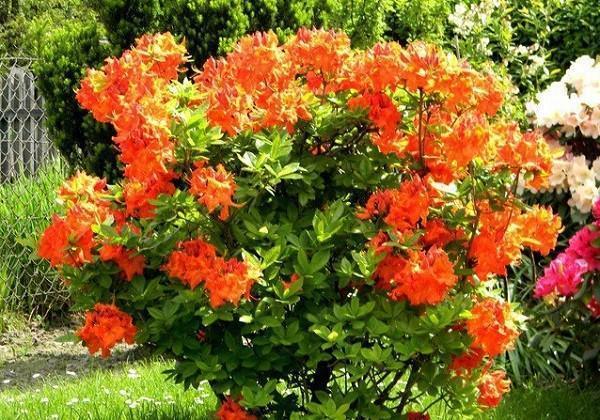Delicate and persistent beauty of the garden - large-flowered deciduous azalea
 The external beauty and tenderness of azaleas are quite deceiving. Despite the fact that most of its varieties are grown exclusively in indoor conditions, there are varieties that are not afraid of the Russian winter. They not only feel good in the open field, but even severe frosts at 30 degrees cannot harm such, at first glance, fragile plants. One of them is azalea deciduous large-flowered.
The external beauty and tenderness of azaleas are quite deceiving. Despite the fact that most of its varieties are grown exclusively in indoor conditions, there are varieties that are not afraid of the Russian winter. They not only feel good in the open field, but even severe frosts at 30 degrees cannot harm such, at first glance, fragile plants. One of them is azalea deciduous large-flowered.
Description of the variety
As already clear from the name of the species, the deciduous azalea is a large group of plants that shed their leaves for a dormant period. Despite this, it is widely used in landscape design due to its spectacular appearance during flowering, when very large inflorescences of a wide variety of colors bloom on the branches. Flowering lasts 2 months, while in its midst, amazing inflorescences cover the entire bush, almost hiding foliage underneath.
The bush grows quite large and can reach a height of 1.5 m.
Among the most beautiful and famous varieties of deciduous azalea are the following varieties:
- Gibraltar;
- Klondike;
- Golden Eagle;
- Irene Koster;
- Persil;
- Cecil and others.
Features of growing and care
For a deciduous azalea, you need to find a bright spot in the garden, but with diffused lighting. If the shrub stays under the sun all day long, you can not wait for flowering, because the leaves will fall off even before the arrival of autumn, and the plant itself will no longer have the strength to set buds.
Like her indoor relatives, azalea grandiflorum prefers light and nutritious soil, therefore it is better to replace a layer of soil 50 cm with a new, light and fertile one.
It is important to water the bush regularly, especially when wonderful flowers are blooming on it. The last water-charging irrigation must be carried out in November, after which the tree-trunk circle is mulched with spruce branches. Azalea also responds well to spraying (but not buds).
Young plants should be fed with mullein in the spring, but blooming azaleas already need minerals such as potassium and phosphorus, which must be added after flowering.
Also, two weeks after the end of flowering, the bushes are trimmed, removing the sluggish and thickening shoots of the bush. The remaining branches are shortened by a third of their length.